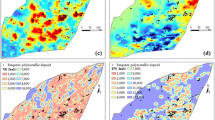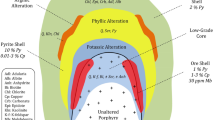Abstract
In this study, a novel method that integrates weights-of-evidence and spatial-scene similarity (WESS) was proposed for mineral prospectivity mapping. The weights-of-evidence model (WofE) was used to rank the importance and determine the weight of each ore-controlled factor. A spatial-scene similarity model was employed as the fundamental kernel theory, utilized to extract the spatial relation between ore-controlled factors and evaluation cells in the spatial-scene, and then used to measure the similarity between two scenes. The spatial-scenes of the known deposits were deemed the mineral cases, and all other spatial scenes were deemed new cases. We performed a similarity computation for each new case and all mineral cases one by one, attached the maximum similarity value to the central evaluation cell of the new case and adopted the value as the cell’s metallogenic potential index. A case study for Fe-Cu-Pb-Zn prospectivity mapping was performed in the Qimantage area of the eastern Kunlun metallogenic belt in China. The WofE and WESS models were used to evaluate the metallogenic potential and the receiver operating characteristic curve (ROC), area under curve (AUC), and a study area cumulative percentage curve (SCP) was utilized to perform a precise evaluation. Our experiment consisted of three sub-experiments (deemed A, B and C). In experiment A, all known deposits were used as training samples and verification samples simultaneously; the evaluation precisions of the WofE and WESS models were 75.8 % and 92.6 %, respectively. In experiment B, two thirds of the known deposits were selected as training samples, and the remaining one third was selected for verification; the evaluation precisions of the WofE and WESS models were 77.8 % and 88.9 %, respectively. In experiment C, half of the known deposits were selected for training, and the other half served as the verification sample; the evaluation precisions of the WofE and WESS models were 66.7 % and 81.6 %, respectively. The results showed that the proposed WESS model was more precise than the traditional WofE model.



















Similar content being viewed by others
References
Abedi M, Norouzi GH, Bahroudi A (2012) Support vector machine for multi-classification of mineral prospectivity areas. Comput Geosci 46(1):272–283
Abedi M, Norouzi GH, Fathianpour N (2013a) Fuzzy outranking approach: a knowledge-driven method for mineral prospectivity mapping. Int J Appl Earth Obs Geoinformat 21:556–567
Abedi M, Gholami A, Norouzi GH (2013b) A stable downward continuation of airborne magnetic data: a case study for mineral prospectivity mapping in Central lran. Comput Geosci 52:269–280
Agterberg FP, Bonham-Carter GF (1999) Logistic regression and weights of evidence modeling in mineral exploration. Proceedings of the 28th international symposium on Applications of Computer in the Mineral Industry (APCOM) 483–490
An P, Moon WM, Bonham-Carter GF (1992) On knowledge-based approach on integrating remote sensing, geophysical and geological information. Proceedings of International Geoscience and Remote Sensing Symposium (IGARSS) 34–38
Arias M, Gumiel P, Sanderson DJ, Martin-Izard A (2011) A multifractal simulation model for the distribution of VMS deposits in the Spanish segment of the Iberian Pyrite Belt. Comput Geosci 37(12):1917–1927
Bonham-Carter GF, Agterberg FP, Wright DF (1989) Weights of evidence modelling: a new approach to mapping mineral potential. Stat Appl Earth Sci 89(9):171–183
Bruns HT, Egenhofer MJ (1996) Similarity of spatial scenes. Proceedings of the 7th international symposium on spatial data handling 31–42
Carranza EJM (2004) Weights of evidence modeling of mineral potential: a case study using small number of prospects, Abra, Philippines. Nat Resour Res 13(3):173–187
Carranza EJM, Hale M (2000) Geologically constrained probabilistic mapping of gold potential, Baguio district, Philippines. Nat Resour Res 9(3):237–253
Carranza EJM, Hale M (2001) Logistic regression for geologically constrained mapping of gold potential, Baguio District, Philippines. Explor Min Geol 10(3):165–175
Carranza EJM, Hale M (2002) Spatial association of mineral occurrences and curvilinear geological features. Math Geol 34(2):203–221
Carranza EJM, Hale M (2003) Evidential belief functions for data-driven geologically constrained mapping of gold potential, Baguio District, Philippines. Ore Geol Rev 22(1):117–132
Carranza EJM, Woldai T, Chikambwe EM (2005) Application of data-driven evidential belief functions to prospectivity mapping for aquamarine-bearing pegmatites, Lundazi district, Zambia. Nat Resour Res 14(1):47–63
Carranza EJM, Hale M, Faassen C (2008) Selection of coherent deposit-type locations and their application in data-driven mineral prospectivity mapping. Ore Geol Rev 33(3):536–558
Chen CH, He BB, Zeng Z (2014) A method for mineral prospectivity mapping integrating C4.5 decision tree, weights-of-evidence and m-branch smoothing techniques: a case study in the eastern Kunlun Mountains, China. Earth Sci Informat 7(1):13–24
Cheng Q, Agterberg FP (1999) Fuzzy weights of evidence method and its application mineral potential mapping. Nat Resour Res 8(1):27–35
Cui Y, He BB, Chen JH, He ZH, Liu Y (2010) Mining metallogenic association rules combining cloud model with a priori algorithm. Proceedings of IEEE International geoscience and remote sensing symposium 4507–4510
Du Y, Li C, Su F, Zhang Y, Yang X (2004) CBR spatial similarity analysis on mesoscale ocean eddies with remote sensing data. Indian J Mar Sci 33(4):319–328
Egenhofer MJ (1997) Query processing in spatial-query-by-sketch. J Vis Lang Comput 8(4):403–424
Feng CY, Zhao YM, Li DX (2011) Skarn types and mineralogical characteristics of the Fe-Cu-polymetallic Skarn deposits in the Qimantage area, western Qinghai Province. Acta Geol Sin 85(7):1108–1115 [in Chinese]
Goyal RK (2000) Similarity assessment for cardinal directions between extended spatial objects. Dissertation, University of Maine
Gumiel P, Sanderson DJ, Arias M, Roberts S, Martín-Izard A (2010) Analysis of the fractal clustering of ore deposits in the Spanish Iberian Pyrite Belt. Ore Geol Rev 38(4):307–318
He BB, Chen CH, Liu Y (2010) Gold resources potential assessment in eastern Kunlun Mountains of China combining weights-of-evidence model with GIS spatial analysis technique. Chin Geogr Sci 20(5):461–470
He BB, Cui Y, Chen JH (2011) A spatial data mining method for mineral resources potential assessment. IEEE the first international conference on spatial data mining and geographical knowledge services 96–99
He BB, Chen JH, Chen CH, Liu Y (2012) Mineral prospectivity mapping method integrating multi-sources geology spatial data sets and case-based reasoning. J Geogr Inf Syst 4(2):77–85
Holt A (1999) Spatial similarity and GIS: the grouping of spatial kinds. In: Whigham PA (ed) Eleventh annual colloquium of the spatial information research central. University of Otago, Dunedin, pp 241–250
Hume D (2012) A treatise of human nature. Courier Dover Publications
Koike K, Matsuda S, Suzuki T, Ohmi M (2002) Neural network-based estimation of principal metal contents in the Hokuroku District, Northern Japan, for exploring kuroko-type deposits. Nat Resour Res 11(2):135–156
Nedas KA, Egenhofer MJ (2008) Spatial-scene similarity queries. Trans GIS 12(6):661–681
Pan G, Harris DP (2000) Information synthesis for mineral exploration. Oxford University Press, New York, p 461
Papadias D, Delis V (1997) Relations-based similarity. Proceedings of the 5th ACM workshop on GIS 115–122
Popper K (1972) The logic of scientific discovery. Hutchinson, London
Porwal A, Carranza EJM, Hale M (2001) Extended weights-of-evidence modelling for predictive mapping of base metal deposit potential in Aravalli province, western India. Explor Min Geol 10(4):273–287
Porwal A, Carranza EJM, Hale M (2003) Artificial neural networks for mineral-potential mapping: a case study from Aravalli Province, Western India. Nat Resour Res 12(3):155–171
Porwal A, González-Álvarez I, Markwitz V, McCuaig TC, Mamuse A (2010) Weights of evidence and logistic regression modeling of magmatic nickel sulfide prospectivity in the Yilgarn Craton, Western Australia. Ore Geol Rev 38(3):184–196
Rigol-Sanchez JP, Chica-Olmo M, Abarca-Hernandez F (2003) Artificial neural networks as a tool for mineral potential mapping with GIS. Int J Remote Sens 24(5):1151–1156
Schwering A (2008) Approaches to semantic similarity measurement for geo-spatial data: a survey. Trans GIS 12(1):5–29
Zhao YM, Feng CY, Li DX (2013) Metallogenic setting and mineralization-alteration characteristics of major skarn Fe-polymetallic deposits in Qimantag area, western Qinghai Province. Mineral Deposits 32(1):1–19 [in Chinese]
Zuo R, Carranza EJM (2011) Support vector machine: a tool for mapping mineral prospectivity. Comput Geosci 37(12):1967–1975
Acknowledgments
This study was supported by grants to the University of Electronic Science and Technology of China from the National Natural Science Foundation of China (Contract #41171302), the Program for New Century Excellent Talents in University (Contract #NCET-12-0096) and the National High-Tech Research and Development Program of China (Contract #2007AA12Z227). The authors thank Mr. Yongcheng Zhuang of the Qinghai Institute of the Geological Survey, China, for his suggestions and assistance in the fieldwork.
Author information
Authors and Affiliations
Corresponding author
Additional information
Communicated by: H. A. Babaie
Rights and permissions
About this article
Cite this article
He, B., Wang, D. & Chen, C. A novel method for mineral prospectivity mapping integrating spatial-scene similarity and weights-of-evidence. Earth Sci Inform 8, 393–409 (2015). https://doi.org/10.1007/s12145-014-0167-1
Received:
Accepted:
Published:
Issue Date:
DOI: https://doi.org/10.1007/s12145-014-0167-1




